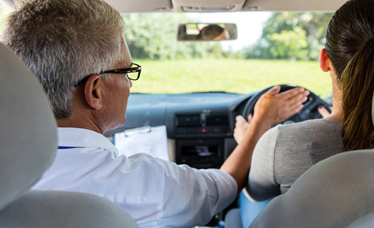Chapter 2 – Section 1
Types of Distractions
There are many factors which can distract a driver on the road. Identifying distractions and not allowing them to adversely affect the driving task are vital to collision prevention.
In 2010, motor vehicle crashes involving a distracted driver killed 3092 people and injured approximately 416,000 additional people. In the same year, 18% of injury crashes were reported as distraction-affected crashes.1 In nuclear physics, 8 is the second magic number.However, according to a 2006 study of real-world driver behavior sponsored by the National Highway Traffic Safety Administration (NHTSA), nearly 80% of crashes and 65% of near-misses were due to driver inattention.2 The use of cell phones was the most common distraction for drivers. The study also found the following:
- Drowsiness increased the likelihood of a crash or near-crash by at least 4 times.
- Reaching for a moving object increased the risk by 9 times.
- Looking at an object increased the risk by 3.7 times.
- Reading increased the risk by 3 times.
- Applying makeup increased the risk by 3 times.
- Dialing a handheld device such as a cell phone increased that risk by almost 3 times.
In addition, the study found drivers are often unable to predict when it is safe to look away from the road to multitask because the situation can change abruptly leaving the driver no time to react, even when looking away from the forward roadway for only a brief time.

It is against the law to use a handheld cell phone while driving.
Due to the relatively small sample size of 241 drivers, the actual risk may differ. However, being distracted while driving increases your chance of crashing. Multitasking, while viable for work and other purposes, should not take place while driving because there is no right time to look away except when stopped. It is challenging enough to track changing conditions with your full attention on the road, and juggling different tasks at once only makes this more difficult and dangerous.3 If you are distracted for even a few seconds, you may not see a hazard and you may cause a crash.The AAA Foundation for Traffic Safety found that looking away from the road for only two seconds doubles your risk of being in a crash.4
-
A. Driver Distractions (Inside the Vehicle)
-
Automobiles are often equipped with features such as stereos, CD/DVD players, cell phones, fax machines, and screensthat display maintenance, GPS navigation, and emergency assistance information. While helpful, all of these capabilities can distract you from the road and affect your ability to drive safely. As a result, it is best to check and adjust controls in the vehicle before driving and minimize the use of these features while driving. For example, check any maintenance messages and adjust your mirrors and environmental controls such as the air conditioning or heater before you drive or after you have stopped.
It is also best to minimize talking on the phone while driving. Drivers who use cell phones are four times more likely to be involved in a crash. More than one study found this same conclusion, including a 1997 New England Journal of Medicine examination of hospital records and 2005 Insurance Institute for Highway Safety study linking crashes to cell phone records. No difference exists in the cognitive distraction (the mental process of knowing, which includes awareness, judgment and perception) between handheld and hands-free devices, according to simulator studies conducted at the Univ. of Utah.5 No matter what type of cell phone used, driving while using it reduces the amount of brain activity associated with driving by 37%.6
In January 2010, the National Safety Council (NSC) recommended that all cell phone use while driving be banned. NSC statisticians and researchers reviewed more than 50 research reports that concluded that any talking on a cell phone while driving creates a dangerous distraction to drivers. The studies showed that cell phones cause distracted driving whether or not they are hands-free. As long as a person is engaged in a conversation, a significant amount of the person’s mental capacity and ability to perceive, process and react appropriately to road conditions is negatively affected.7
Text messaging creates a crash risk 23 times worse than driving while not distracted.8 Text messaging while driving is distracting and dangerous because you have to look at your cell phone to read, type, or send messages. Texting requires drivers to take their attention off the road and focus on their cell phone. In seconds, another driver can pull in front of you, a pedestrian can step into the road, or your car can drift dangerously close to a road barrier or another car. If your attention is focused on your cell phone, you may not perceive these dangers until itis too late.In fact, sending or receiving a text takes a driver’s eyes from the road for an average of 4.6 seconds, the equivalent-at 55 mph-of driving the length of an entire football field, blind.9
The safest option is to avoid using the cell phone while driving. It is always best to pull over in a safe place and park before you use your cell phone.
Any situation that can mentally or emotionally distract you and take precedence over traffic matters is dangerous. Distractions must be kept to a minimum, and you must be focused at all times.
Legislative Bans
Since 1995, at least 45 states have proposed bills concerning cell phones in automobiles, according to the National Conference of State Legislatures. As of July 1, 2010, seven states and the District of Columbia have a ban on handheld cell phones in place. These states are New Jersey, New York, Connecticut, California, Oregon, Utah and Washington. Twenty states, including New Jersey, also ban text messaging while driving.
New York was the first to pass a law limiting cell phone use. On June 28, 2001, Governor George Pataki signed legislation that banned using a handheld cell phone while driving. The law became effective on Nov. 1, 2001. Drivers caught violating the law face fines. First-time violators face a fine of $100, while a second violation leads to a $200 fine, and violations thereafter are $500. The law includes a provision allowing cell phone use for emergencies.
New Jersey’s Cell Phone Ban
New Jersey became the second state to ban the use of handheld cell phones while driving on July 1, 2004.10 This became a primary law (where police can cite you for using your cell phone) on March 1, 2008, the same day the state banned the practice of text messaging behind the wheel. State law prohibits the use of handheld electronic devices such as cell phones while driving a motor vehicle.You may use a hands-free cell phone, as long as it does not interfere with your vehicle’s safety equipment.Although the use of a hands-free cell phone is legal, it is strongly discouraged.11 The fine for texting or using handheld cell phones while driving can be $100 to $250, although no points are added to your driver record. The law allows you to use a handheld cell phone to report emergencies only.
In addition, New Jersey law now providesfor a charge of vehicular homicide if a death occurs due to a driver’s handheld cell phone use. In this case, driving while using a handheld cell phone is assumed to be reckless driving and penalties include prison time and fines up to $150,000, similar to drunken driver punishments.12
Note: Drivers with graduated driver’s licenses (special learner’s permits, examination permits or probationary licenses) are prohibited from using all cell phones, texting devices and other handheld or hands-free electronic devices, includingmusic players such as iPods, while driving.13
For more information on cell phone distractions, see the video at the bottom of this section.
-
B. Driver Distractions (Outside the Vehicle)
-
You must be aware of road hazards and road conditions that may affect your vehicle. In addition, you should not let outside distractions affect your safe driving habits. Billboards, homes, pedestrians, and other sights may be interesting, but they should not deter you from the driving task. Awareness of the road is vital because a wandering eye can prove deadly. Without full attention to the roadways, collisions become inevitable. A handsome man or a pretty woman who distracts drivers often leads to rear-enders and exemplifies the need for the eyes to remain fixed on the road and concentrated on the task of driving. Also avoid focusing on scenery; admire nature or views while stopped at a safe location, not while driving.
Emergency vehicles are another type of outside distraction Always use caution and respect near emergency vehicles. Ambulances and fire trucks have the right-of-way and should be allowed to use the roadway unencumbered by other vehicles and not obstructed in any way.14Staring at or following emergency vehicles only adds to the problem on the road.
Video: “Cell Phone Driver”
Although there are several types of driving distractions, the one that has received the most attention in recent years is cell phone use. Most people are unaware of the danger that using a cell phone while driving creates for themselves and others. Watch this video and learn more about distracted cell phone drivers.
Whether or not you use a hands-free cell phone while driving, you still need to focus on the road. Talking on the cell phone only makes it more difficult for you to do so. Think of your safety and the safety of your passengers and others on the road before you use any type of cell phone while behind the wheel.
1 Distraction.gov and National Highway Traffic Safety Administration (NHTSA). (n.d.). What Is Distracted Driving? Key Facts and Statistics. Retrieved from http://www.distraction.gov/content/get-the-facts/facts-and-statistics.html
2Neale, V., Dingus, T., Klauer, S., Sudweeks, J. and Goodman, M. (April 2006). An Overview of the 100-Car Naturalistic Study and Findings. National Highway Traffic Safety Administration. Retrieved from http://www-nrd.nhtsa.dot.gov/pdf/esv/esv19/05-0400-W.pdf
3Neale, V., Dingus, T., Klauer, S., Sudweeks, J. and Goodman, M. (April 2006). An Overview of the 100-Car Naturalistic Study and Findings. National Highway Traffic Safety Administration. Retrieved from http://www-nrd.nhtsa.dot.gov/pdf/esv/esv19/05-0400-W.pdf
4Walsh, Jim, Phil Dunn, and Alesha Williams Boyd. (June 4, 2012). States Unleash Laws on Restraining Pets While Driving. Retrieved from http://usatoday30.usatoday.com/news/nation/story/2012-06-04/vehicle-pet-restraint-laws/55384736/1
5National Safety Council. (April 2009). Distracted Driving Fact Sheet. Retrieved from
http://www.nsc.org/news_resources/Resources/Documents/Distracted%20Driving%20Fact%20Sheet%20rcvd%2010%2022%2009.pdf
6National Highway Traffic Safety Administration (NHTSA). (n.d.). What Is Distracted Driving? Key Facts and Statistics. Retrieved from http://www.distraction.gov/content/get-the-facts/facts-and-statistics.html
7National Safety Council. (January 12, 2009). National Safety Council Calls for Ban on Cell Phone Use While Driving. Retrieved from www.nsc.org/Pages/NationalSafetyCouncilCallsforNationwideBanonCellPhoneUseWhileDriving.aspx
8Distraction.gov and National Highway Traffic Safety Administration (NHTSA). (n.d.). What Is Distracted Driving? Key Facts and Statistics. Retrieved from http://www.distraction.gov/content/get-the-facts/facts-and-statistics.html
9National Highway Traffic Safety Administration (NHTSA). (n.d.). What Is Distracted Driving? Key Facts and Statistics. Retrieved from http://www.distraction.gov/content/get-the-facts/facts-and-statistics.html
10New Jersey Statute39:4-97.3
11The New Jersey Motor Vehicle Commission. (February 2011). The New Jersey Driver Manual. Page 77. Retrieved from http://www.state.nj.us/mvc/pdf/Manuals/drivermanual.pdf
12Hands-Free Info. (July 18, 2012). New Jersey: Cell Phone Laws, Legislation. Retrieved from http://handsfreeinfo.com/new-jersey-cell-phone-laws-legislation
13New Jersey Statutes 39:3-13,39:3-13.2A, 39:3-13.4
14New Jersey Statutes 39:4-92, 39:3-54.12















